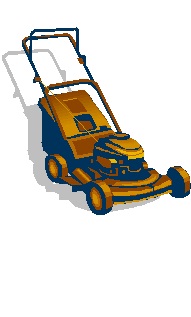 Lawn Mower Maintenance - January 25, 2012 Jeff Schalau, Agent, Agriculture & Natural Resources University of Arizona Cooperative Extension, Yavapai County Proper mowing begins with functional, well-maintained equipment. How is your mower doing? Is it doing more damage than good to your lawn? Is the blade sharp and balanced? Can the mowing height be adjusted and are all the wheels set at the same height? Are you mowing at the correct height for your turfgrass type? How often should your lawn be mowed? I will address these topics and assume that most people with lawns are using rotary mowers as opposed to reel mowers. A well-mowed lawn should have an even surface and the leaf blades should have a cut rather than a shredded appearance. Get on your hands and knees and look at the mowed grass tips. If the blade tips look as if they were beaten with a disc sander, then your blade is probably dull and/or out of balance. To check this out on a rotary mower, disconnect the spark plug wire and remove the spark plug. Next, look under the deck. If the blade feels dull, then it needs sharpening. This can be done at home with the proper equipment (a big metal file or grinder), but it is critical that the blade remain balanced and the correct cutting angle (about 45 degrees). If you are confused at this point, take the mower or blade to a repair shop to be sharpened. An oil change, cleaning the air filter, and replacing the spark plug will also keep the mower running smooth. There is also a possibility the crankshaft is bent if you are in a rocky area – this is a bigger problem. If your freshly mowed lawn has an uneven surface and the ground underneath is smooth, check the wheel heights (front and back) by using a tape measure. Never do this while the mower is running and if you need to touch the blade, remove the spark plug. Next, roll the mower onto an even surface such as a concrete slab. If the wheels do not all touch the floor, then at least one of the wheels is not properly adjusted. You should also check to see if the front wheels are the same height as the back. Take your measuring tape and measure the vertical distance from the floor to the mower deck at each wheel. These distances should be the same at each wheel. Once properly adjusted, you may want to use a permanent marker to mark the wheel adjustors. Once your mower is sharp and level, determine the proper mowing height. Kentucky bluegrass (and bluegrass blends), perennial rye, and fine fescues should be mowed between 2.5 and 3.5 inches in height. Tall fescue should be mowed between 3 and 4 inches. A law of mowing that cannot be broken is the “one-third” rule. This rule tells you never to remove more than one-third of the total grass height during any one mowing. To remove more than one-third is to “scalp” it, which severely stresses the turf. I recommend mowing taller rather than shorter. This maximizes the photosynthetic leaf area, which will allow the grass to manufacture and store more energy. It also promotes deeper root growth, which increases drought resistance during the summer months. Mowing frequency depends on the growth rate and the one-third rule. If you have recently fertilized, then the turf may require more frequent mowing. Remember: do not scalp and mow high if possible. Bermudagrass, a warm season grass, can be mowed shorter than the cool season grasses mentioned above. However, you must be careful not to scalp it during the summer. In addition, you may be tempted to overseed it with ryegrass in the winter. This is not recommended for our elevation because the rye persists and competes with the bermudagrass during the summer. If you have bermudagrass, just get used to the straw color during winter. If your current mower is beyond help, consider replacing it with a mulching mower. This design requires no bagging and returns clippings to the lawn. Mulch-mowing saves time and makes a lawn greener and healthier by recycling the nutrients contained in the grass clippings. Mulching mowers have specially designed blades that keep the mowed grass suspended longer under the mower deck. This chops and re-chops the clippings. The finely chopped clippings settle down into your lawn where they disappear from sight and decompose on the soil surface. Mulch mowing should be done every five to seven days during the spring. Some mulch mower designs also can be converted to bagging mowers. This is a handy feature when grass is growing rapidly or to collect weed seeds to minimize their spread. If you have other gardening questions, call the Master Gardener help line in the Camp Verde office at 928-554-8999 Ext. 3 or e-mail us at cottonwoodmg@yahoo.com and be sure to include your name, address and phone number. Find past Backyard Gardener columns or provide feedback at the Backyard Gardener web site: http://cals.arizona.edu/yavapai/anr/hort/byg/. |